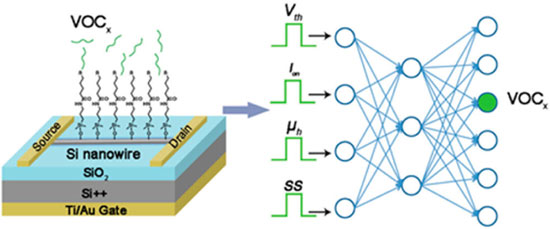| Posted: Jan 30, 2014 | |
Electronic nose with artificial sensing intelligence |
|
| (Nanowerk Spotlight) A field effect transistor (FET) is a type of transistor that relies on an electric field to control the shape and hence the conductivity of a 'channel' in a semiconductor material. Several years ago, it was shown in a series of experiments that a silicon nanowire can be used as the source-drain channel in FETs. | |
| Subsequently, it was shown that these nanowire field-effect sensors show significant advantages of real-time, label-free and highly sensitive detection of a wide range of analytes in liquid phase, including proteins, nucleic acids, small molecules, and viruses in single-element or multiplexed formats (read more: "Amplifying biomolecular signals with nanoscale field effect transistors"). | |
| "In contrast to the liquid phase, it has been a challenge to obtain selective silicon nanowire field effect transistor (SiNW FET) sensors for gaseous chemical species, such as, volatile organic compounds (VOCs) that are associated with environmental pollution, quality control, explosive materials, or various diseases," says Hossam Haick, a professor in the Department of Chemical Engineering and Russell Berrie Nanotechnology Institute at Technion - Israel Institute of Technology. | |
| Over the years, Haick's Laboratory for Nanomaterial Based Devices has worked on the detection of cancer-related VOCs and breath samples using E-noses based on gold nanoparticle and carbon nanotube chemresistors (see our previous Nanowerk Spotlight on this work: "Nanotechnology sensor can 'smell' lung cancer in exhaled breath"). | |
| "Motivated by the unique features of the SiNW FET sensors and the ease to integrate these sensors in the currently available VLSI technology, we tried to use molecularly modified SiNW FETs to detect VOCs," Haick tells Nanowerk. "We found that one SiNW FET sensor could provide multiple sensing signals towards VOCs. Further, we noticed that the multiple sensing character of one SiNW FET was similar as that of a sensor array. Thus, the concept of E-nose can rely on one SiNW FET sensor to selectively detect VOCs." | |
| This work, which has been reported in the January 17, 2014 online edition of Nano Letters ("Artificial Sensing Intelligence with Silicon Nanowires for Ultraselective Detection in the Gas Phase"), is based on the electronic nose (E-nose) concept – electronic devices which mimic the olfactory systems of mammals and insects. | |
 |
|
| Scheme of a molecularly modified SiNW FET sensor (Reprinted with permission from American Chemical Society) | |
| The selectivity of E-noses towards analytes are achieved by analyzing sets of sensing signals using pattern recognition methods, rather than selectively adsorbing analyte on sensor site ('lock-and-key' approach). | |
| "In traditional E-noses, sensor arrays are always used to generate fingerprint patterns for analytes," explains Haick. "However, in our study, the applied E-noses contain one sensor only, but they are able to identify many kinds of analytes." | |
| He adds that the use of one FET sensor in an E-nose can minimize the device size, decrease the power consumption, and simplify the device circuitry and related computation parts. | |
| The approach relies on the use of multiple independent parameters of a specific molecularly modified SiNW FET (e.g., voltage threshold, hole mobility, subthreshold swing) as input for artificial neural network (ANN) models, which, in turn, can be trained in its ensemble to make the targeted detection. This means that, relying on the raw responses of each SiNW FET sensor, ANN models are employed to seek selectivity toward specific VOCs. | |
| The researchers say that the artificial sensing intelligence with SiNW FETs can be applied in environmental monitoring and disease diagnosis in the gas phase. | |
| In addition, this approach can be applied in other FET based sensor applications to selectively detect analytes in both gas and liquid phase. | |
| Haick points out that this work and the underlying research combine two areas: sensor design and pattern recognition algorithms. | |
| "For the sensor design, developing SiNW FET sensors with high sensitivity, fast response, and longtime stability is required towards various real world applications. For the pattern recognition algorithm, developing and optimizing algorithms to decrease the data processing time consumption, increase the prediction accuracy, and increase the ability to treat sensing data obtained in complex system like multi VOC mixtures, are required and of great importance." | |
| "Efficient combination of sensor designing and pattern recognition algorithm is the key, and also a great challenge, for the future artificial sensing intelligence sensor research," he concludes. | |
 By
Michael
Berger
– Michael is author of three books by the Royal Society of Chemistry:
Nano-Society: Pushing the Boundaries of Technology,
Nanotechnology: The Future is Tiny, and
Nanoengineering: The Skills and Tools Making Technology Invisible
Copyright ©
Nanowerk LLC
By
Michael
Berger
– Michael is author of three books by the Royal Society of Chemistry:
Nano-Society: Pushing the Boundaries of Technology,
Nanotechnology: The Future is Tiny, and
Nanoengineering: The Skills and Tools Making Technology Invisible
Copyright ©
Nanowerk LLC
|
|
|
Become a Spotlight guest author! Join our large and growing group of guest contributors. Have you just published a scientific paper or have other exciting developments to share with the nanotechnology community? Here is how to publish on nanowerk.com. |
|
